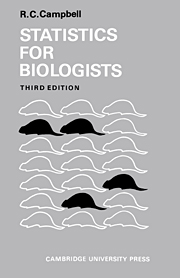Book contents
- Frontmatter
- Contents
- PREFACE
- PREFACE TO SECOND EDITION
- PREFACE TO THIRD EDITION
- 1 WHAT IS STATISTICS ABOUT?
- 2 PRESENTING THE INFORMATION CONTAINED IN ONE SAMPLE
- 3 COMPARING SEVERAL SAMPLES
- 4 ASSOCIATION
- 5 CHOOSING BETWEEN ACTIONS
- 6 THE NORMAL DISTRIBUTION
- 7 THE NORMAL VARIABLE IN EXPERIMENTS AND SURVEYS
- 8 ASSOCIATED NORMAL VARIABLES
- 9 SOME NON-NORMAL DISTRIBUTIONS
- FURTHER READING
- REFERENCES
- APPENDIX: TABLES AND FIGURES FOR STATISTICAL TESTS AND EXERCISES
- INDEX
5 - CHOOSING BETWEEN ACTIONS
Published online by Cambridge University Press: 05 June 2012
- Frontmatter
- Contents
- PREFACE
- PREFACE TO SECOND EDITION
- PREFACE TO THIRD EDITION
- 1 WHAT IS STATISTICS ABOUT?
- 2 PRESENTING THE INFORMATION CONTAINED IN ONE SAMPLE
- 3 COMPARING SEVERAL SAMPLES
- 4 ASSOCIATION
- 5 CHOOSING BETWEEN ACTIONS
- 6 THE NORMAL DISTRIBUTION
- 7 THE NORMAL VARIABLE IN EXPERIMENTS AND SURVEYS
- 8 ASSOCIATED NORMAL VARIABLES
- 9 SOME NON-NORMAL DISTRIBUTIONS
- FURTHER READING
- REFERENCES
- APPENDIX: TABLES AND FIGURES FOR STATISTICAL TESTS AND EXERCISES
- INDEX
Summary
The problem
In the preceding chapters we have developed the inductive process to the point where we can make statements about single parameters, or differences between parameters, with a certain degree of confidence, in the sense that if we use our procedures repeatedly they will give us correct answers in a known proportion of occasions of use. For certain purposes this form of knowledge is not adequate. Suppose for example that, being concerned in the manufacture of micro-pipettes, we want to know whether to allow a certain batch from the production line to be sent out to wholesalers. We could set up a test procedure to measure the average volume given by the pipettes in our batch, with confidence limits for this average, and we could be sure that the calculation leading to these limits would enable us to enclose the true average in a specified proportion of batches. However this information by itself would be of rather limited use; we still would have to decide whether or not to accept the batch, and this decision would depend on our judgement of the seriousness of the difference between the desired volume and the batch average volume. In other words, we ought to use our prior ideas about how important any particular deviation was, and it would seem sensible to try to combine these prior ideas with the knowledge (and uncertainty) obtained from the test procedure so as to have an objective rule to tell us what to do.
- Type
- Chapter
- Information
- Statistics for Biologists , pp. 136 - 155Publisher: Cambridge University PressPrint publication year: 1989



